Kagyu Center Prepares for First Three-Year Retreat
Based on Many Years of Experience and Preparations
Written by: Bill Spangle
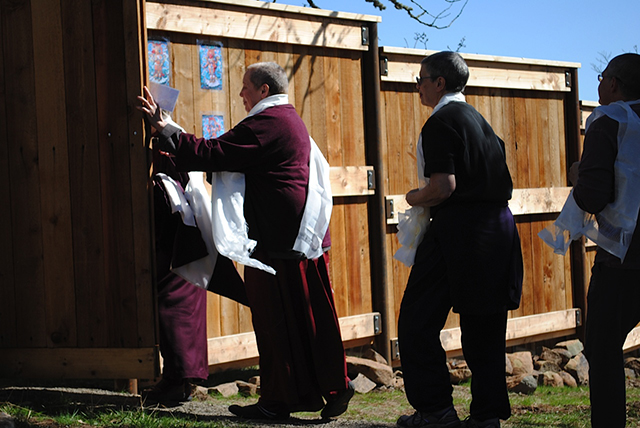
Retratants entering the gate as the one-year retreat is sealed. From left, Kay Hartsock, Kathleen Heron, Peg Swift.
Photos by: Dora DeCoursey, Sanje Elliott, Karen Nelson, Marci Roth, Bill Spangle
In early spring of 2015 a group of men and women will file into their respective cloisters to begin the first traditional three-year retreat at Ser Chö Ösel Ling (SCOL) retreat center— The Land of the Clear Light Golden Dharma.
This center for long retreats, nestled among the pine and oaks along a ridge in the hills above Goldendale, Wash., will be their home for the next three years.
Living as monks and nuns for the duration of the retreat, they will remain in solitude, engaging in the contemplations and meditation practices handed down through the Shangpa Kagyu lineage of Tibetan Buddhism.
The beginning of this retreat will be a major milestone in the realization of a vision set in motion more than 15 years ago by Lama Michael Conklin and the members of Kagyu Changchub Chuling (KCC), a Buddhist center in Portland, Ore., founded in 1976 by the late Kalu Rinpoche.
In the 1990s, shortly after Lama Michael joined the center, the community began to set a course for the future. Taking a longer view, we concluded that if the dharma was going to have a chance to take root here, we would not only have to make the dharma accessible to those fresh to the path in our already crowded urban center, we would also need to ensure that there would be teachers available in the future.
Without some people going deeper into the practice, and teaching from that experience, it was clear that over time, the dharma would lose depth and vitality, moving from lived experience toward a tradition resting only on intellectual understanding and the reputation of previous generations.
The confidence in this vision came from a growing appreciation of the benefits of having access to a teacher who had the chance to do three-year retreat himself. While we were inspired by remarkable teachers like Kalu Rinpoche and his successor Bokar Rinpoche, who had dedicated in excess of a decade each to intensive retreat, it was easy to fall under the spell of the idea that that kind of practice was something done only by adepts from exotic Asian locales, many of whom had passed away.
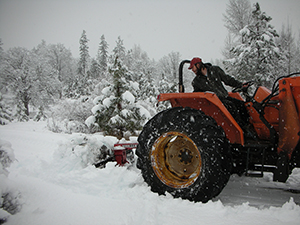
Operations manager plowing the road during winter.
The presence of Lama Michael and his ability to provide clear advice based on experience gained in three-year retreat made it feel like this kind of practice was in fact something that normal people could do. And not only was it something we could do, it was something that we must do if future generations would have the benefit of the same precious opportunity we were experiencing.
Thus we decided that building a place for long retreat was our priority even though the center in Portland was (and still is!) regularly at capacity. Our conviction that it would only take a few years was humorously optimistic, but it did provide the bravado needed to get started.
From the time of the initial purchase of the 240 acres in 2001, KCC has made use of the land for retreats, initially camping out while using the small farm house as a kitchen and meeting in a large tent.
Over the years, as we gradually raised nearly $3 million, we have built roughly 9,500 square feet of facilities, permitting us to move indoors and to begin more regular group and personal retreats. These include the annual North American Mahamudra Seminar initiated by Bokar Rinpoche, and an annual two-month winter season retreat.
This activity has culminated in a one-year group retreat at the SCOL retreat center, which is following the curriculum of the KCC Mahamudra seminar. The one-year retreat will conclude this March 29. The three year retreat is to begin one year later.
Life on retreat
During the three years retreatants will remain in their cloister, only leaving in case of emergency. This discipline both requires and supports great clarity of purpose.
The cloister provides protection as well, freeing retreatants from the need to invest energy maintaining a public face for chance encounters. There are two nearly identical cloisters for women and men, connected by a central building with the kitchen, pantry and staff work spaces, allowing staff to serve both cloisters.
Each cloister has eight cabins where retreatants practice and sleep, as well as a dining hall, bath house, a meditation hall for group practice, and a yoga hall for the specialized yogas that are done in the last year of the retreat.
Each cloister also contains a 200-yard walking path inside the fenced area, to permit exercise during the breaks between sessions.
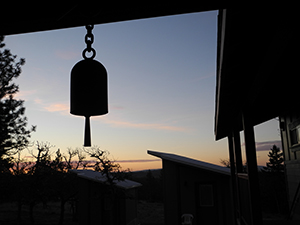
The bell in the south cloister at sunrise.
While silence is a common discipline on retreats, three-year retreats are rarely done entirely in silence. On long retreat some discussion and interaction with fellow retreatants can be helpful for mutual support, and can also help to diffuse preoccupations that can become exaggerated in extended silence.
Depending on the particular group on retreat, the retreat master may adjust the discipline of silence accordingly. But in general most of each day will be spent in silence, and there will also be periods of complete silence as well.
Within the retreat itself, the rhythm of life will be governed by the bell that marks the beginning and end of the meditation sessions.
Each day on retreat will include roughly 12 hours in formal meditation sessions, which will be spread over a day that will begin at 3 a.m. and come to a close at 9 p.m. Though there will be two group practice sessions each day and simple meals taken together, the retreatants will spend most of their time in individual practice in their own rooms.
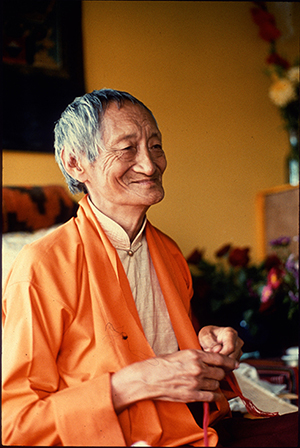
Changchub Chuling’s Founder, the venerable Kalu Rinpoche.
The retreat teachers will visit every few weeks to provide instructions for new meditation methods, and to meet individually with the retreatants.
The retreat will be led primarily by Lama Michael Conklin, and by Lama Tara Goforth from British Columbia.
Both of them did three-year retreats led by lamas appointed by the late Kalu Rinpoche, and both have collaborated for many years leading retreats including the current one-year retreat at SCOL.
Lama Tara has also assisted in teaching on two other three-year retreats. Lama Tsang Tsing, who was retreat master for Lama Michael’s retreat, will also provide teaching and guidance.
The length of a three-year retreat is often challenging to contemplate just by itself. Although there are esoteric teachings that are cited to explain the precise length, the prosaic reasons for extended retreat are more helpful to understand the character of the retreat.
One of the simpler reasons for the length is that the curriculum of the retreat includes most of the essential practices of the lineage, so even three years makes for a compressed schedule.
And as the retreat progresses, each succeeding practice depends on experiential understanding gradually gained in the practices that came before, so there needs to be time to become familiar with each practice in turn. In this regard practice in the retreat is more akin to developing strength and skill in athletic training, than the accumulation of facts through study.
In addition to the length of the retreat, the curriculum of practice is unfamiliar territory for those accustomed to thinking of meditation mainly as allowing the mind to settle in order to cultivate insight, or similar practices.
While these types of meditation are done throughout the three-year retreat, a large part of the time is spent engaging in Vajrayana meditation methods.
While there is not space here to explain these methods in satisfying detail, one of the most central principles of these practices is that instead of gradually letting the mind settle and gradually uprooting negative tendencies, the practice involves actively taking the perspective of a Bodhisattva– one whose very being is dedicated to the liberation of all beings– as the basis for the meditation. These practices directly work with all dimensions of our capacity to create and sustain our image of reality and personal identity.
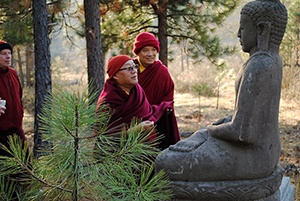
Khenpo Lodro Donyo Rinpoche with basalt Buddha statue near the cloisters. Lama Michael Conklin and Lama Tashi Dondrup behind.
A central part of the practice is to view ourselves and all other beings as Bodhisattvas. Over the course of the retreat the practices become more subtle and gradually set the stage to work with realms of experience like dreams, deep sleep and the expression of basic life energies that are usually beyond the reach of ordinary awareness.
As the insight into the nature of confusion and suffering deepens, the understanding of compassion also goes to deeper and deeper levels.
While the curriculum of the retreat provides a remarkable set of tools to develop compassion and foster insight, just setting aside the preoccupations of ordinary life for three years makes many things possible that are otherwise very difficult.
Quite simply, in the middle of ordinary life it is quite hard to see how the seductive momentum of habitual patterns plays out or how these patterns shape our sense of personal reality. It feels natural to think that our experience primarily depends on what is happening to us and around us. It is hard to imagine otherwise.
When we can deeply set aside past projects and identities and cease plans for the future, it is possible to see how the momentum of our habits and personal style carries on independent of the things we usually credit or blame for our state of mind. In this space we can begin to see how we are, in a very deep way, the authors of our own experience.
This can in turn open the possibility that we might leave unwritten stories driven by negative habits and instead cultivate the seed of Bodhicitta– the wish to free all beings from suffering– as the driving force in our life.
For me, after five or so months on a one-year retreat, I began to notice that the ups and downs I experienced seemed to have less and less to do with what was going on immediately around me, and more and more like they were just familiar patterns. The image came to me that these patterns of experience were like the flow of a river, placid at times, then churning rapids, veering to one side, then the other.
Looking at a river, the flow can easily be explained by the shape of canyon walls and bedrock. Before retreat I would have said that the patterns of my experience were likewise dependent on life conditions. But now the conditions of life had been simplified to the rhythm of sessions announced by the bell.
Yet the river of my patterns flowed on, independent of conditions. It felt as surprising as it would be to watch the Colorado River continue its serpentine course, even though the Grand Canyon, which seemingly had directed it, had disappeared into space.
In the space of retreat many kinds of momentary experiences and glimpses of insight can arise. While there is no certainty that these experiences will deeply ripen in the short term, they can give increased confidence in the potential of the path. It is our hope that in offering this three-year retreat, and others in the future, KCC will contribute toward building a tradition of intensive retreat practice in our culture.
May these retreats benefit not only those who take part but also all those whose lives they touch, whether directly or indirectly.
The year between the one-year retreat and three-year retreat will be a busy one. KCC will be taking advantage of this time to do group and personal retreats at SCOL, including a month of retreat in May.
Please check kcc.org for more information. The facility will be available to other Buddhist groups for retreats as well.
And there is still work to do to be fully ready for three-year retreat, including raising funds to complete a residence for retreat staff. There are still some spaces available on the retreat and openings for retreat support staff. For those interested participating in the retreat, or who wish to help support the retreat, please contact Julia King Tamang at jtamang@easystreet.net.










